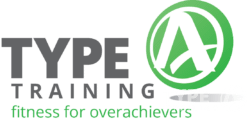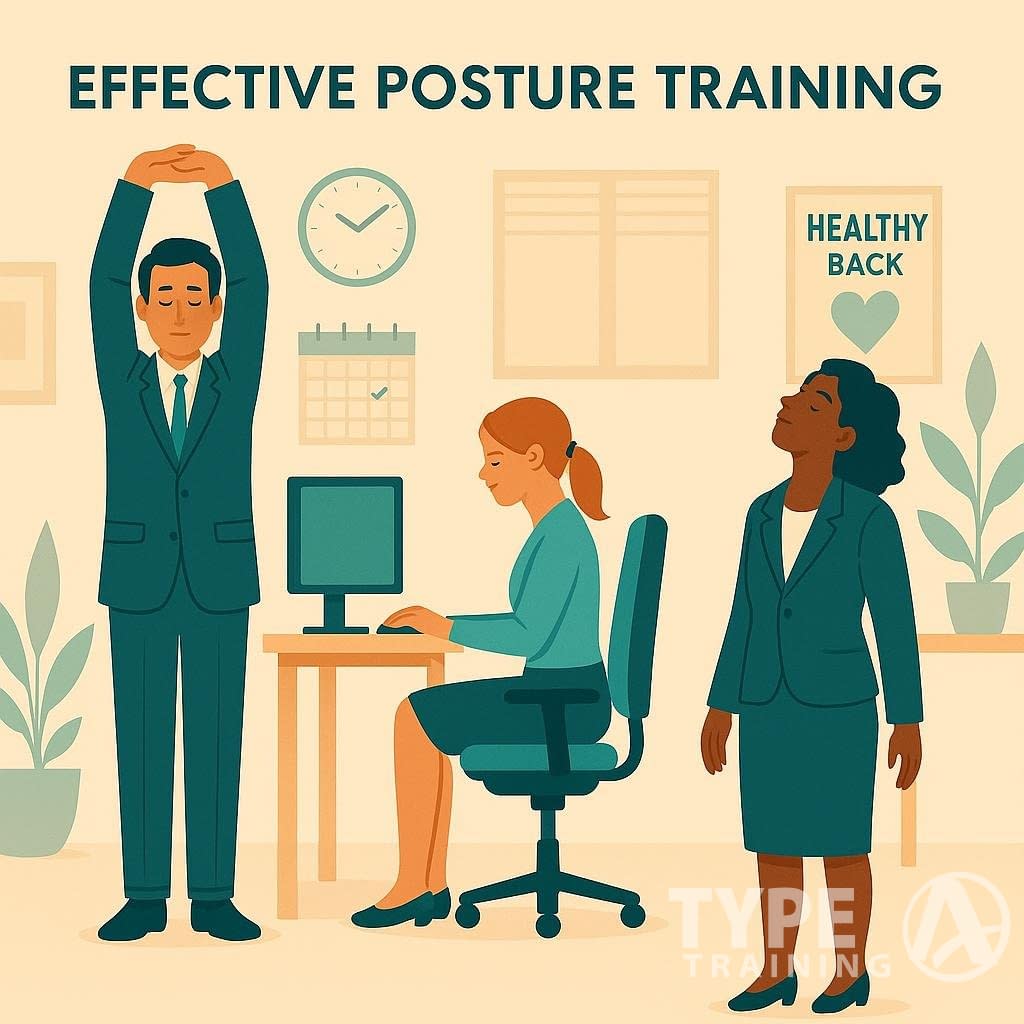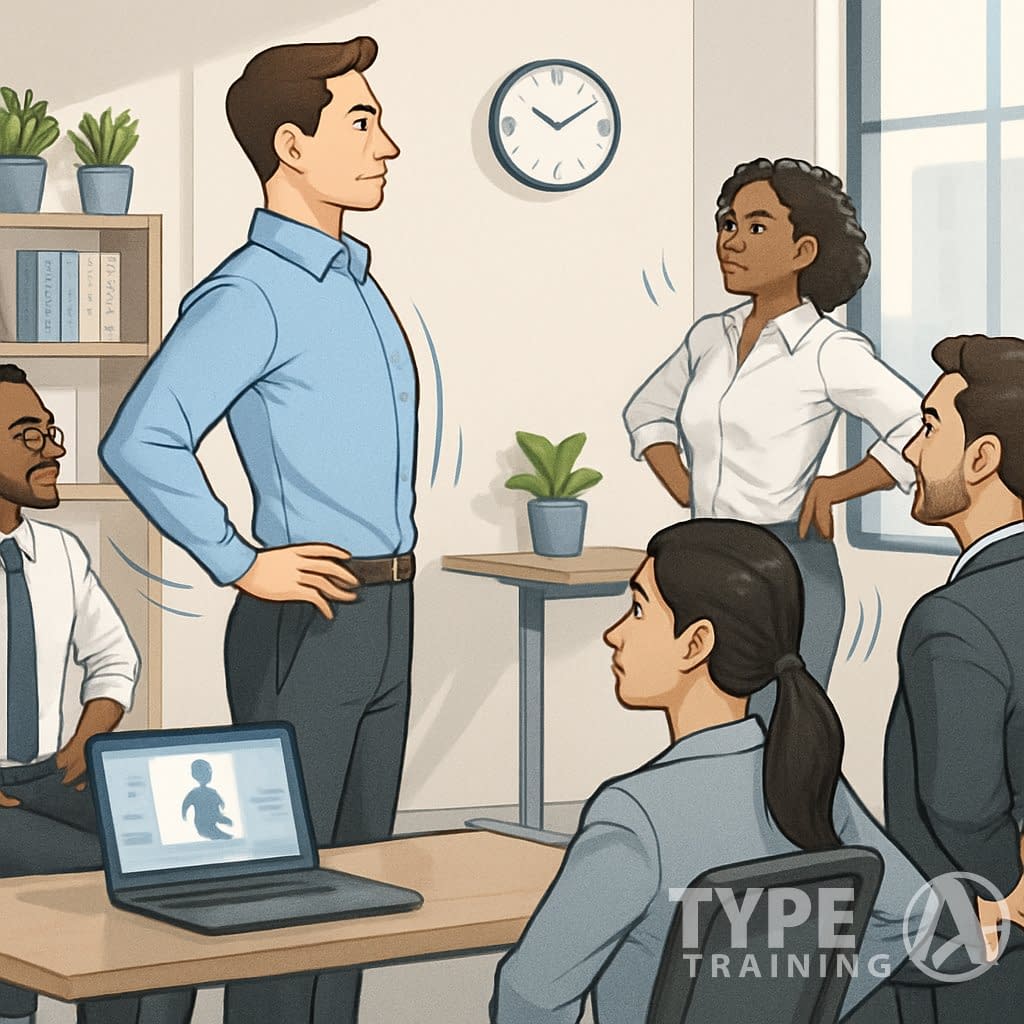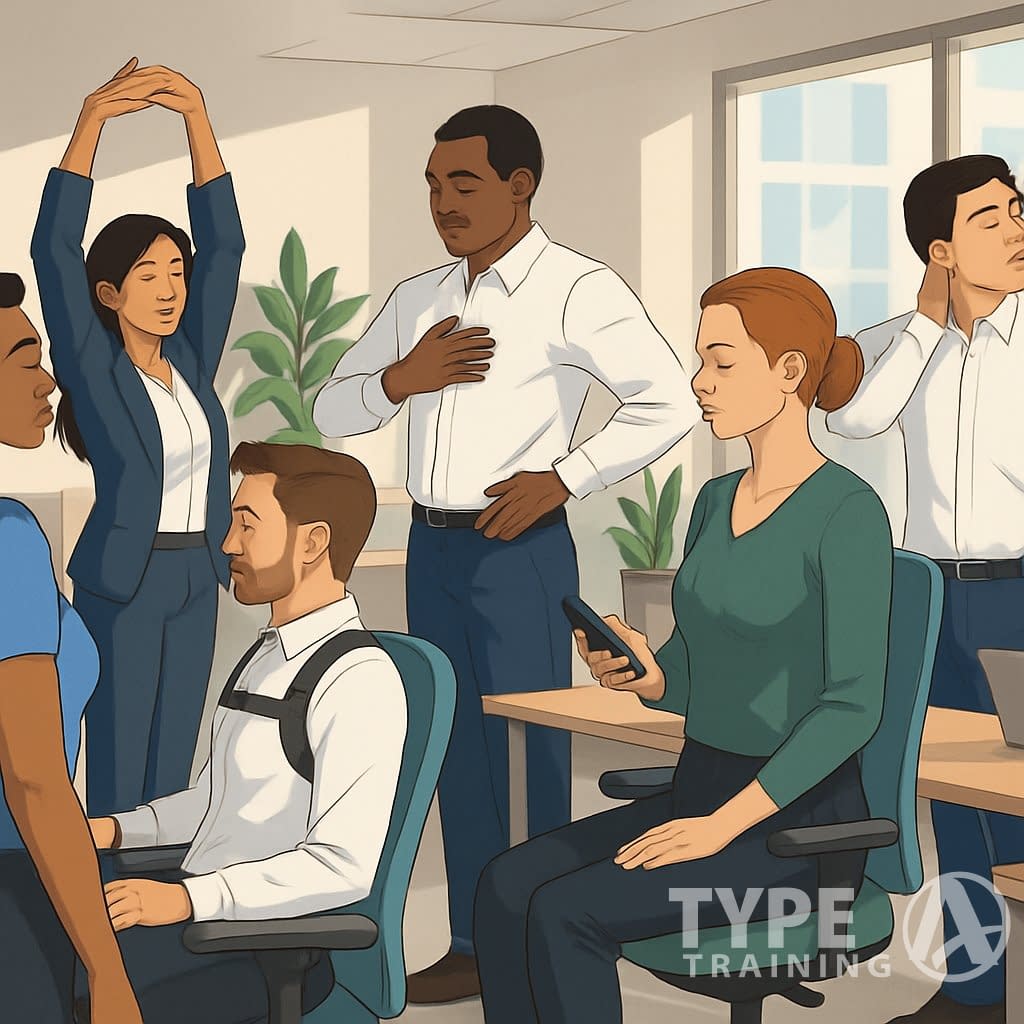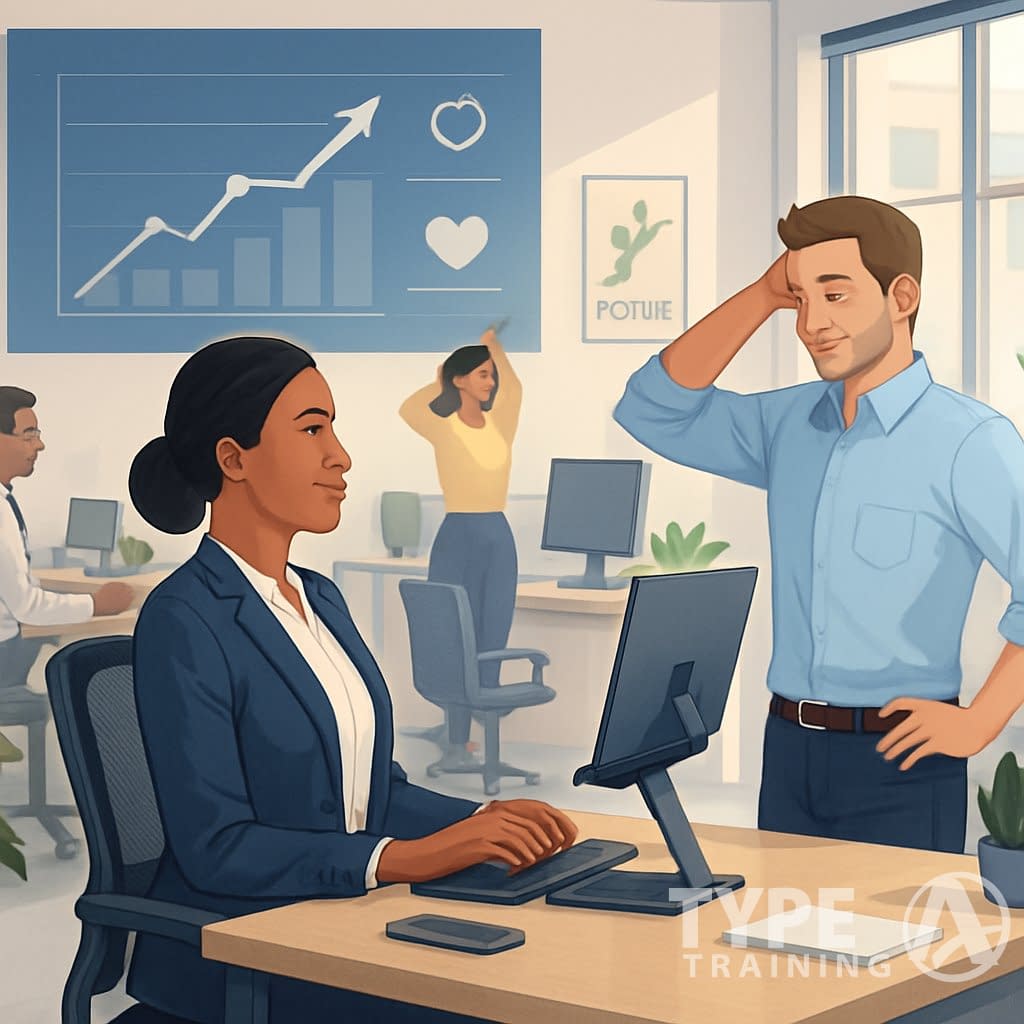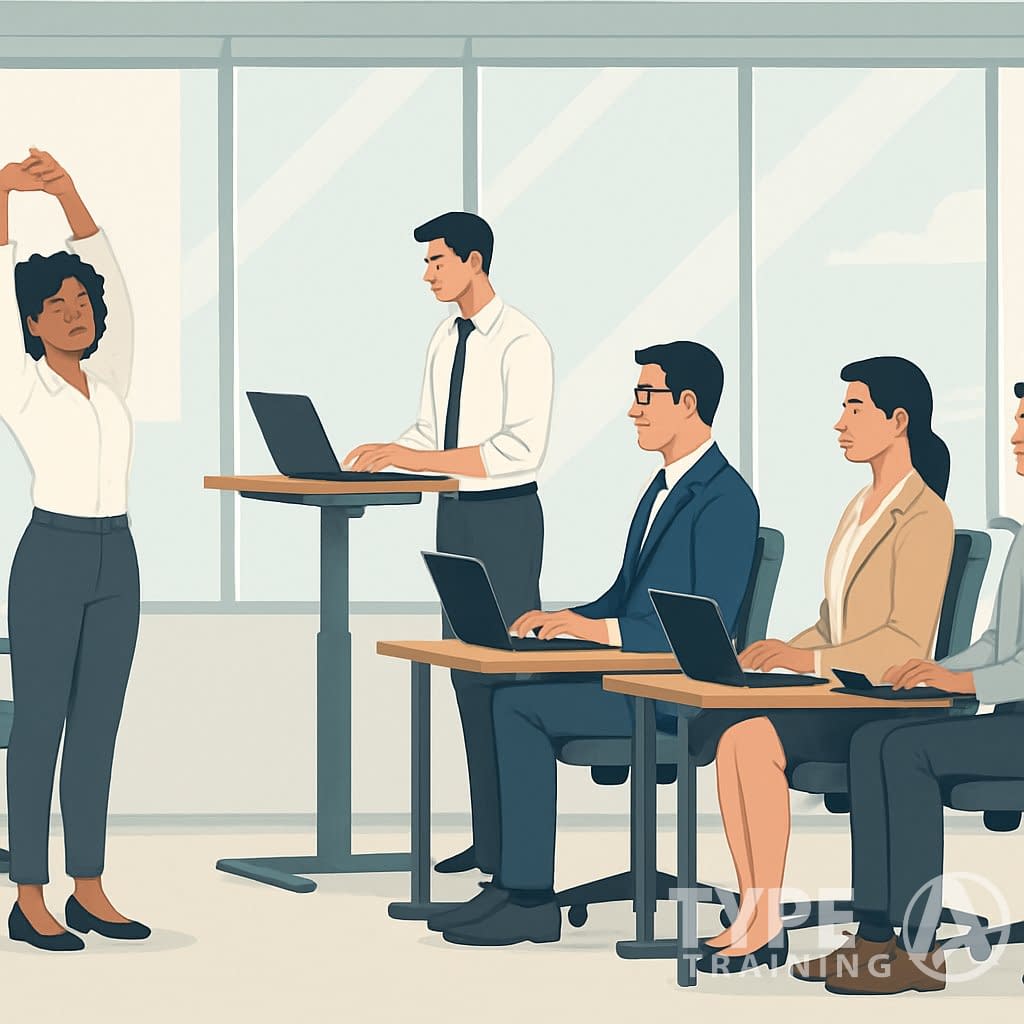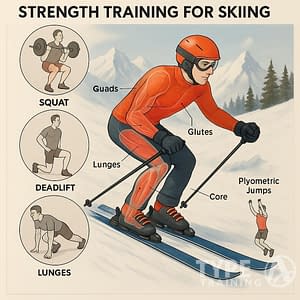Long hours at your desk, endless meetings, and constant screen time really take a toll on your body. Poor posture from sitting all day leads to back pain, neck stiffness, and low energy that wrecks your focus and productivity.
A lot of busy professionals think they don’t have time to fix these problems. That’s just not true.
You can improve your posture and reduce pain with just 5-10 minutes of simple exercises and small workspace changes throughout your day. Effective posture training doesn’t require a gym membership or hour-long workouts.
Quick stretches, better desk setup, and short movement breaks can make a real difference in how you feel and perform. Small changes add up over time.
Popular posts:
When you sit and stand properly, your muscles work better and you breathe easier. You’ll probably notice a boost in energy too.
Good posture also helps you look more confident and professional. The trick is building habits that fit into your schedule without adding more stress.
Key Takeaways
- Poor posture from desk work causes pain and reduces energy, but simple daily exercises can fix these problems.
- Small workspace changes and movement breaks throughout the day improve alignment without taking much time.
- Consistent posture training builds stronger muscles, better breathing, and increased confidence over time.
Why Posture Matters for Busy Professionals

Good posture affects your physical health, mental state, and work performance. Poor posture creates muscle imbalances and back pain, and drains your energy and focus.
Physical and Mental Benefits of Good Posture
Proper posture can bring immediate relief from common workplace pain. Your spine stays aligned, reducing pressure on your back and neck.
Good posture improves your breathing patterns. With your body lined up, your lungs have more space to expand, so you get better oxygen flow to your brain and muscles.
Key Physical Benefits:
- Less back pain and neck strain
- Better muscle balance
- Improved breathing and circulation
- Less tension in shoulders and upper back
Your energy levels go up when your body works efficiently. Poor posture makes your muscles work harder just to keep you upright, which wears you out.
Good posture even affects your mental health. Research shows upright posture can boost confidence and reduce stress hormones.
You’ll feel more alert and focused when your body’s properly aligned.
Common Postural Challenges in Desk Jobs
Desk work creates specific posture problems. Your head moves forward as you lean toward your screen, straining your neck and causing “tech neck.”
Your shoulders roll forward from typing and using a mouse. This rounded position tightens your chest and weakens your upper back.
Most Common Issues:
- Forward head posture from screen viewing
- Rounded shoulders from keyboard use
- Curved lower back from poor chair support
- Tight hip flexors from constant sitting
Slouching in your chair flattens your lower back, putting extra pressure on your spine. Many professionals end up with chronic lower back pain from this.
Hip flexor muscles get tight from sitting all day. These tight muscles pull on your lower back and mess with your walking posture even after work.
Impacts of Prolonged Sitting and Sedentary Lifestyles
Sitting for long periods affects your whole body. Muscles get weak and imbalanced when they stay in the same position for hours.
Blood flow slows down when you sit too long. Poor circulation causes swelling in your legs and feet.
A sedentary lifestyle bumps up your risk for serious health problems like heart disease, diabetes, and obesity. Even regular exercise doesn’t totally cancel out the effects of sitting all day.
Health Impacts Include:
- Weakened core and back muscles
- Reduced metabolism and weight gain
- Increased risk of chronic diseases
- Poor blood circulation
Productivity drops when pain distracts you. Back pain and neck strain make it tough to focus on work.
When your breathing is restricted, your brain gets less oxygen. That mental fatigue really adds up and makes decision-making harder.
Fundamentals of Effective Posture Training
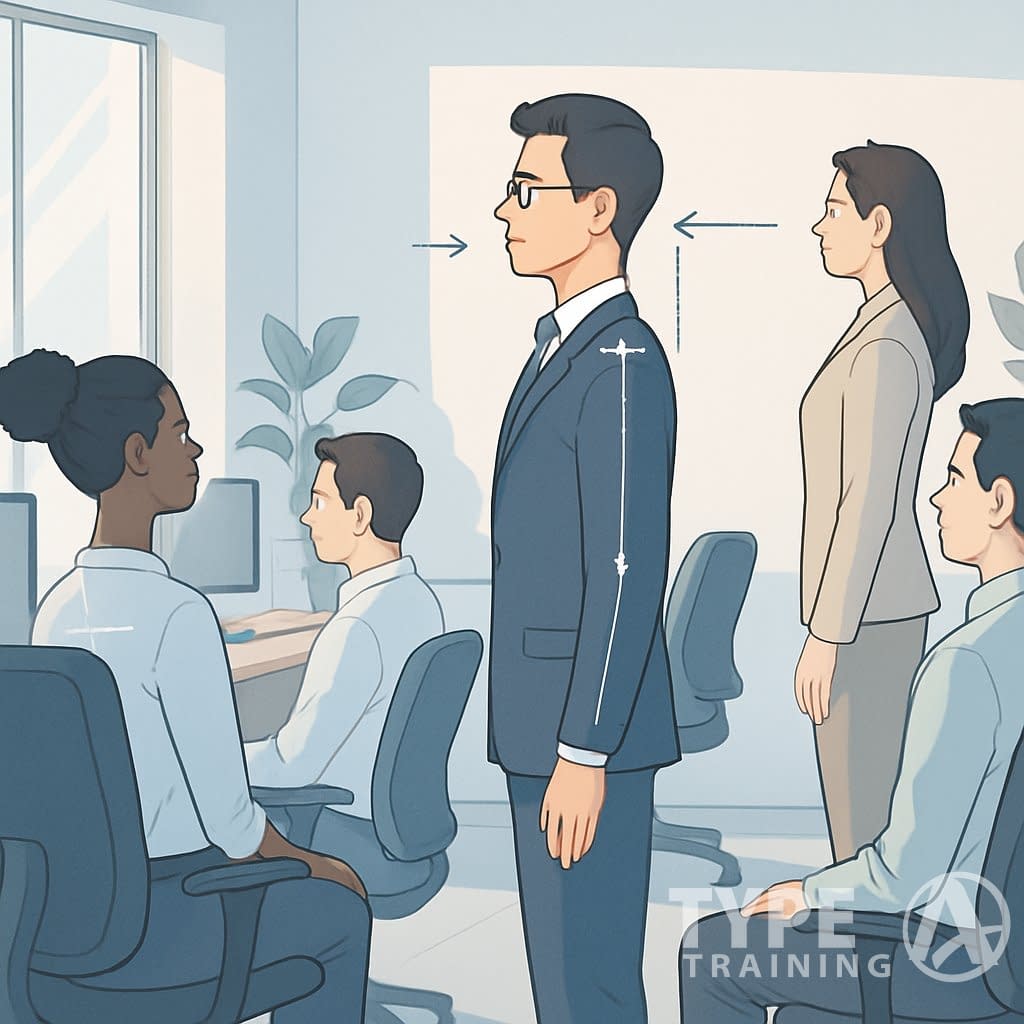
Effective posture training means setting achievable targets and understanding the muscle imbalances that throw off your alignment. Forward head posture and rounded shoulders are the most common issues for professionals glued to their desks.
Setting Realistic Goals for Posture Improvement
Your posture goals should be specific and measurable. Start with small changes you can actually track.
Short-term goals (2-4 weeks):
- Hold proper sitting position for 30 minutes without reminders
- Do 5 minutes of daily posture exercises
- Notice when you slouch and fix it right away
Long-term goals (3-6 months):
- Cut neck and shoulder tension by half
- Maintain good posture for full workdays
- Build muscle strength to support alignment naturally
Take photos or use posture apps to track progress. Jot down pain levels and energy throughout the day so you can see real changes.
A certified fitness trainer can help you set realistic goals and spot problems you might miss.
Identifying and Correcting Postural Imbalances
Muscle imbalances happen when some muscles are too tight and others are too weak. That’s the recipe for bad posture.
Common muscle imbalances in professionals:
- Tight chest, weak upper back
- Tight hip flexors, weak glutes
- Overactive neck muscles, weak deep neck muscles
Test your posture by standing against a wall. Your head, upper back, and butt should touch easily.
If your head pulls forward or your back arches too much, something’s out of balance. Muscle tension often builds in your shoulders, neck, and lower back since they’re working overtime.
Fixing imbalances means both stretching tight muscles and strengthening weak ones. Focus on muscle pairs that oppose each other, like chest and upper back.
Recognizing Forward Head and Rounded Shoulders
Forward head posture is when your ears jut out in front of your shoulders instead of lining up above them. This puts extra stress on your neck.
Signs of forward head posture:
- Neck pain and headaches
- Tight muscles at the base of your skull
- Double chin look
- Upper back stiffness
Rounded shoulders roll inward toward your chest. Your upper back curves too much and your chest gets tight.
Signs of rounded shoulders:
- Shoulders don’t sit level
- Chest feels tight and closed off
- Upper back pain between shoulder blades
- Arms hang with palms facing backward
These problems usually show up together. Hours spent looking at screens pull your head forward and round your shoulders.
Your upper back gets weak while your chest and neck muscles stay tight. Both issues respond well to targeted exercises and workspace tweaks.
Catching these patterns early makes them much easier to fix.
Essential Posture Exercises for Busy Schedules
Better posture comes from targeted exercises that strengthen your core, stretch tight muscles, and wake up weak postural muscles. These three categories fit even the busiest schedules—5 to 20 minutes is enough.
Bodyweight Exercises and Quick Circuits
Planks are the backbone of any posture routine. Hold for 30 seconds and work up to two minutes.
Planks strengthen your whole core and teach good spinal alignment. Try standard planks, then move to side planks for extra oblique and stability work.
Glute bridges help with weak glutes and lower back problems. Lie on your back, knees bent, squeeze your glutes, and lift your hips. Hold for a couple seconds, repeat 15-20 times.
Wall push-ups are a great starting point. Stand at arm’s length from a wall and do push-ups against it to strengthen upper back muscles.
Here’s a quick circuit:
| Exercise | Time/Reps | Rest |
|---|---|---|
| Plank | 30-60 seconds | 15 seconds |
| Glute bridges | 15 reps | 15 seconds |
| Wall push-ups | 12 reps | 15 seconds |
| Bird dog | 10 each side | 15 seconds |
Repeat 2-3 times for a full-body workout in just 10-15 minutes.
Desk and Office-Friendly Movements
Chair squats fire up your glutes while you work. Sit down and stand up from your chair—no hands. Do 10-15 reps every hour.
Seated leg raises target your hip flexors and core. Sit tall, lift one knee toward your chest, hold for five seconds, then switch. Ten times per leg.
Desk push-ups work your chest and shoulders. Put your hands on the desk edge and do push-ups at an angle. Go for 10-15 reps.
Try these desk exercises throughout your day:
- Shoulder blade squeezes: Pull your shoulder blades together and hold for five seconds.
- Neck retractions: Pull your chin back to make a double chin, hold for five seconds.
- Seated spinal twists: Rotate your upper body left and right, keeping hips forward.
Set a timer to remind yourself every 30-60 minutes. Moving regularly keeps your muscles from getting stuck in bad positions.
Stretching and Mobility Workouts
Upper body stretches help undo the damage from hunching over screens. The doorway chest stretch opens up tight chest muscles.
Stand in a doorway, arm against the frame. Step forward until you feel a stretch across your chest. Hold for 30 seconds per arm.
Neck stretches loosen up tension from looking down all day. Gently tilt your head to each side, holding for 15-20 seconds.
Dynamic stretching beats static stretching for posture. Try:
- Arm circles: 10 forward, 10 backward
- Cat-cow stretches: On hands and knees, arch and round your back 10 times
- Hip circles: Stand and rotate hips in circles 10 times each way
You can do these desk stretches while seated:
- Seated figure-4 hip stretch
- Seated hamstring stretch
- Upper trap stretch
Spend 5-10 minutes on stretching exercises at the start or end of your workday. Focus on spots that feel tight or stuck.
Time-Efficient Training Methods for Professionals
Busy professionals need workout methods that deliver maximum results in minimum time. Strategic 30-minute sessions using high-intensity intervals, portable equipment, and targeted mobility work can match the benefits of longer traditional workouts while fitting into demanding schedules.
High-Intensity Interval Training (HIIT) and Tabata
HIIT alternates bursts of intense exercise with short rest periods. In just 20-30 minutes, you can burn more calories than with steady-state cardio.
Basic HIIT Structure:
- Work: 20-45 seconds at about 85-90% effort
- Rest: 10-30 seconds of active recovery
Total HIIT sessions run 15-30 minutes. That’s plenty for most people.
Tabata uses a strict 4-minute protocol. You go all out for 20 seconds, rest for 10 seconds, and repeat 8 times.
Effective Tabata Exercises:
- Kettlebell swings
- Burpees
- Mountain climbers
- Jump squats
Circuit training blends strength and cardio by rotating through exercises with little rest. You’ll work your whole body and still get your heart rate up.
Sample 20-Minute Circuit:
- Push-ups (45 seconds)
- Squats (45 seconds)
- Plank (45 seconds)
- Rest (30 seconds)
Repeat this for 4-5 rounds if you can.
Resistance Band and Equipment-Free Routines
Resistance bands give you a full-body workout anywhere. They’re light, packable, and keep tension on your muscles the whole time.
Essential Resistance Band Exercises:
- Band pull-aparts for your upper back
- Banded squats for legs and glutes
- Chest presses for pushing strength
- Rows for pulling strength
Bodyweight circuit training needs no equipment at all. You can do these in an office, hotel, or right at home.
Quick Bodyweight Routine (15 minutes):
- Wall sits: 30 seconds
- Desk push-ups: 10 reps
- Calf raises: 15 reps
- Chair dips: 8 reps
Repeat the sequence three times.
Office-Friendly Options:
- Climb stairs during lunch
- Take walking meetings for calls
- Do desk stretches between tasks
Brisk walking for 20-30 minutes keeps your heart healthy and can easily replace a treadmill session.
Incorporating Mobility and Flexibility Drills
Mobility work keeps you loose and helps with posture. Just 5-10 minutes a day can make a real difference.
Morning Mobility Sequence (5 minutes):
- Neck rolls: 5 each direction
- Shoulder shrugs: 10 reps
- Arm circles: 10 forward, 10 backward
- Hip circles: 10 each direction
- Ankle rolls: 10 each foot
Desk Break Stretches:
- Seated spinal twist
- Shoulder blade squeezes
- Neck side bends
- Wrist flexor stretches
Dynamic stretches before a workout get you ready to move. Save static stretches for after, when you want to wind down and loosen up.
Evening Wind-Down Routine:
Focus on spots that get tight from work. Hold each stretch for 30-60 seconds and breathe deeply.
Pay special attention to your hip flexors, hamstrings, and chest. Sitting and hunching forward all day tightens these muscles.
Integrating Posture Training into Busy Lifestyles
Building posture habits into your day doesn’t have to be complicated. A few smart changes at work and some accountability can keep you on track, even when life gets hectic.
Creating Consistent Daily Habits
Start small and tie posture checks to things you already do. Do a quick posture reset when you sit at your desk or stand up after a meeting.
Set your phone to remind you every 30 minutes. When it buzzes, roll your shoulders back and check your sitting position for 10 seconds.
Morning routine ideas:
- Stretch for 2 minutes while coffee brews
- Check posture in the bathroom mirror
- Do shoulder rolls on your commute
Sneak in stretches while waiting for the elevator or during phone calls. Chin tucks are easy to do anytime.
Don’t overcomplicate things. Pick one or two simple moves you can do anywhere. Once those feel natural, add more.
Keep a checklist and mark off days you stick with your routine. It’s a surprisingly effective way to build momentum.
Weekly goals:
- Stand up every hour, 5 days a week
- Do desk stretches 4 times
- Practice good posture during 3 long meetings
Even 10 minutes of movement a day can help your posture muscles stay strong.
Workplace Tips: Standing Desks and Walking Breaks
A standing desk lets you mix things up. Try standing 15-30 minutes each hour at first, then slowly increase.
Switch between sitting and standing every 30-45 minutes. This keeps you from getting tired and helps your muscles stay active.
Standing desk tips:
- Put your screen at eye level
- Use an anti-fatigue mat
- Wear comfy, supportive
shoes - Ease in—don’t rush
Walking breaks aren’t just good for your body; they clear your head too. Take a 2-3 minute walk every hour, even if it’s just around the office.
Try walking meetings for calls or one-on-ones. It’s a sneaky way to add movement without losing work time.
Put walking breaks on your calendar so you actually take them.
Quick ways to move:
- Walk to a coworker’s desk instead of emailing
- Take the stairs
- Park farther away or get off the bus a stop early
- Walk during lunch
All of this helps your work-life balance. Better posture means less fatigue and a clearer mind.
Boosting Motivation and Accountability
Find a colleague or friend who wants to work on posture too. Check in with each other about stretches and movement breaks.
Create group reminders or workplace challenges. Set a team goal for hourly movement breaks or desk stretches.
Apps and fitness trackers can help. Many will nudge you to stand up or move, which is great for posture.
Accountability ideas:
- Share progress photos with a friend
- Join an online posture group
- Track habits in a journal or app
- Celebrate small wins each week
Notice how good posture feels—more energy, less back pain, better focus. Connect it to your bigger well-being goals.
Better posture isn’t just about health. You might notice more confidence in meetings and fewer sick days from back pain.
Don’t get discouraged if you miss a day. Consistency matters more than perfection.
Long-Term Benefits and Progress Tracking
Good posture training pays off over time. You’ll see improvements in physical health, mental sharpness, and productivity if you stick with it.
Reducing Back and Neck Pain
Slouching puts extra stress on your spine and neck. It’s a big reason so many office workers have chronic pain.
You might notice relief within 2-3 weeks of regular posture exercises. Muscles get stronger and start supporting your spine better.
Pain reduction benefits:
- Lower back strain drops by 40-60% after 6 weeks
- Neck tension eases up within a month
- Headaches become less frequent
- Muscle fatigue goes down during the day
Track your pain each week on a 1-10 scale. Most people see scores fall from 7-8 to 3-4 in two months.
Core muscles usually strengthen first, then your back and shoulders catch up.
Improving Energy and Immune System
Better posture boosts your energy and overall health. When your spine lines up right, your body just works better.
Breathing gets easier and deeper with good posture. More oxygen reaches your muscles and brain.
Energy perks you might notice:
- Less afternoon fatigue
- Better sleep from less muscle tension
- Improved circulation
- A stronger immune system
With less stress on your body, your immune system can do its job. Jot down how you feel at 2 PM each day—energy tends to improve by 30-40% after six weeks.
Enhancing Work Performance and Well-Being
Posture affects your mental state and job performance. Sitting and standing tall brings more oxygen to your brain.
Confidence grows when you stand tall. Studies say upright posture leads to fewer negative thoughts and better self-esteem.
Work benefits:
- Better focus for longer stretches
- More creativity and problem-solving
- Less stress on busy days
- Higher quality of life
Track your focus or productivity each day. Many professionals see a 20-25% boost in focus within a month.
Less physical discomfort means a better mood and relationships at work.
Frequently Asked Questions
Posture training uses exercises to strengthen weak muscles and stretch tight areas from too much sitting. You can fit these moves in at your desk or at home.
What are the best daily exercises for correcting poor posture?
Focus on moves that build your core and upper back while stretching your hip flexors and chest. Wall angels are great for shoulder mobility and upper back strength.
Cat-cow stretches loosen your spine. Hold each pose for 3-5 seconds, repeat 10 times.
Add planks to build core strength. Hold for 30-60 seconds a day—your spine will thank you.
Chin tucks help with forward head posture. Pull your chin back, lengthen your neck, hold for 5 seconds, repeat 10 times.
Don’t skip hip flexor stretches. Kneel in a lunge, push your hips forward, and hold for 30 seconds on each side.
Can physical therapy exercises significantly improve posture in adults?
Absolutely—if you stick with them. Physical therapy exercises rebuild weak muscles and stretch the tight ones that come from years of slouching.
Full-range resistance training can really help. It strengthens what’s weak and loosens what’s tight.
Manual therapy and posture correction exercises reduce stiffness and teach you better movement patterns.
You’ll need to practice these regularly. Most adults see changes in 4-8 weeks with daily effort.
How can one incorporate posture training into a busy work schedule?
Try micro workouts—just 5 minutes here and there. Set reminders every couple of hours for quick posture exercises at your desk.
The 20-20-20 rule works: every 20 minutes, stand up for 20 seconds, and look 20 feet away. It breaks up sitting and resets your posture.
Use downtime for stretches. Neck stretches while waiting for meetings, shoulder rolls between tasks.
Schedule posture breaks like meetings. Block 5-10 minutes on your calendar for movement.
Keep resistance bands nearby for quick upper back work—rows and shoulder squeezes are easy between calls.
What examples of upper back exercises can help in maintaining good posture?
Prone Y-raises target your middle traps and rear delts. Lie face down, lift arms in a Y shape, hold for 3 seconds, repeat 15 times.
Wall slides are great for upper back and shoulder mobility. Stand against a wall, slide your arms up and down while keeping contact.
Resistance band rows hit your rhomboids and middle traps. Pull the band to your ribs, squeeze your shoulder blades, do 15-20 reps.
Face pulls with a band build rear delts. Pull the band to face level, separate your hands, and fight that forward shoulder slump.
Doorway chest stretches open tight chest muscles. Place your arm on a doorframe, step forward, and feel the stretch.
Are there posture improving practices that can be done at one’s desk?
Seated spinal twists are easy to try right in your office chair. Just rotate your torso left, then right, while your hips stay facing forward. Hold each twist for about 10 seconds.
Shoulder blade squeezes fit seamlessly into desk work. Pull your shoulder blades together and hold for five seconds. Try to repeat this ten times every hour or so—if you remember.
Neck stretches can undo some of that forward head posture from too much computer time. Tilt your head gently to each side and hold for 15 seconds. Feels pretty good, honestly.
Seated figure-four stretches help loosen up tight hip flexors from all that sitting. Put your ankle on your opposite knee and lean forward, but don’t force it.
Upper trap stretches can ease neck and shoulder tension. Tilt your head away from the side you want to stretch and gently pull your shoulder down. It’s simple, but surprisingly effective.
What are the most effective at-home exercises for seniors to improve posture?
Chair-based exercises work well for seniors with mobility issues. Seated rows with resistance bands can strengthen your upper back—no need to get down on the floor.
Wall push-ups offer a gentler alternative to the regular kind. Just stand about an arm’s length from the wall and push against it.
Standing marches are great for your core and hips. Try lifting your knees up toward your chest, one at a time, for about 30 seconds.
Heel and toe raises help your calves and ankles. Hold onto a chair for balance if you want, and just rise up onto your toes, then back onto your heels.
Gentle yoga poses like mountain pose or warrior pose encourage better alignment. If you need extra support, grab a chair and modify the poses as you see fit.
